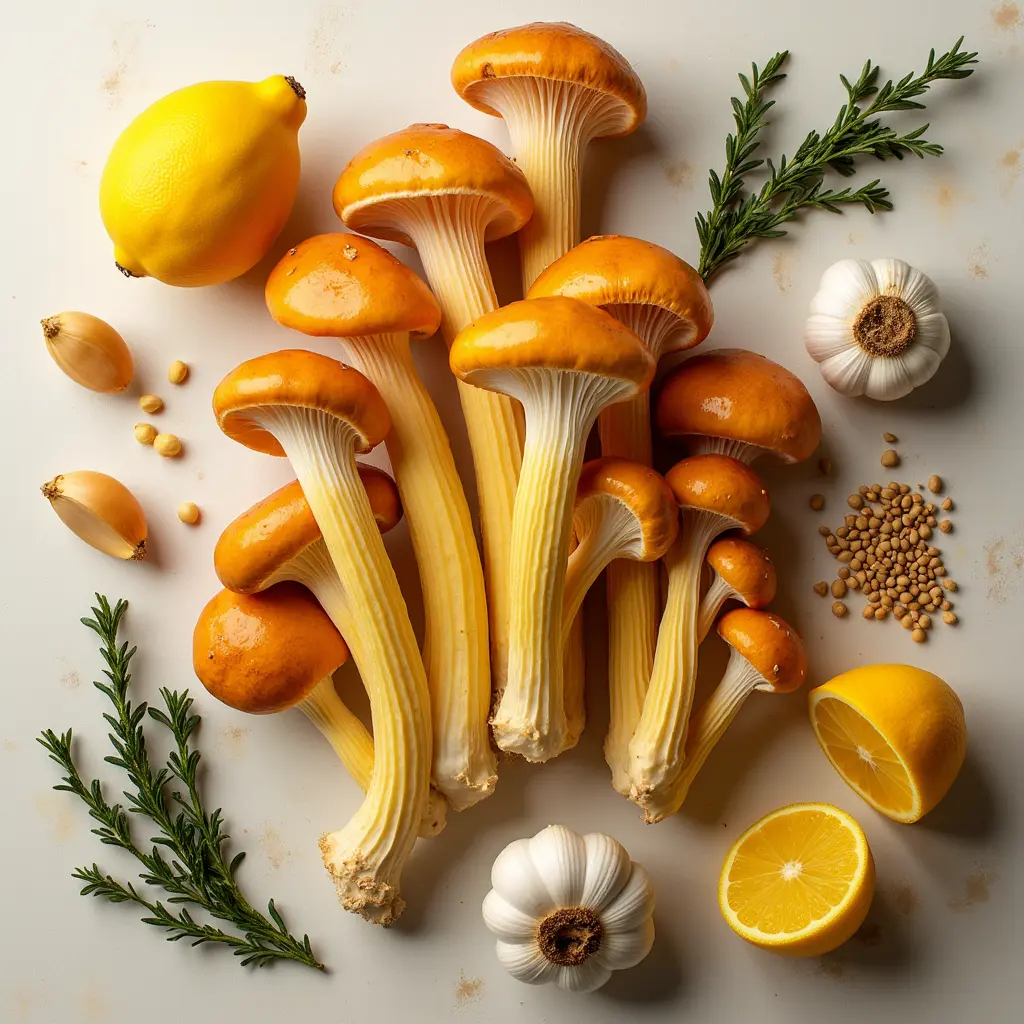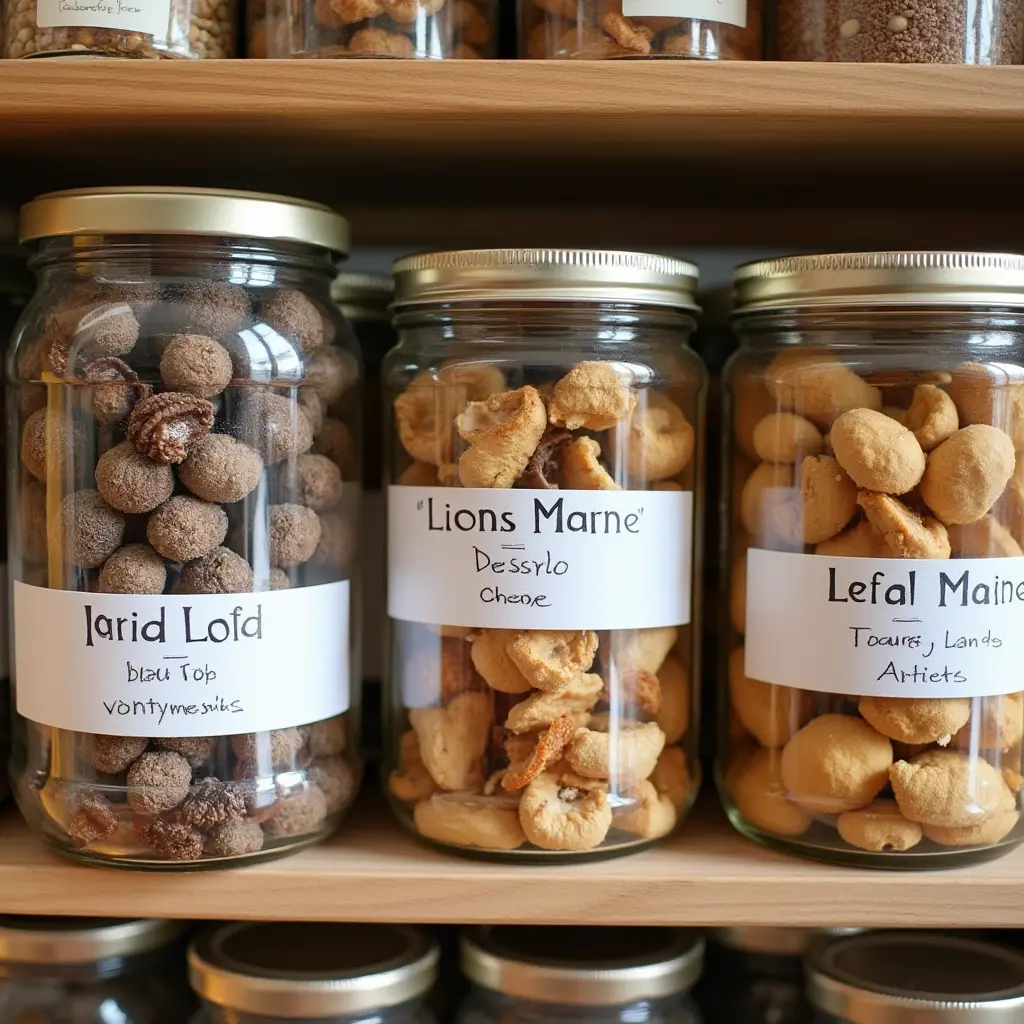Mushrooms are nature’s hidden gems, but have you heard about lion’s mane mushrooms ? These unique fungi aren’t just visually striking—they’re also packed with nutrients that support cognitive function and overall well-being. In this article, we’ll explore why everyone is raving about lion’s mane mushroom recipes and share some mouthwatering ideas to incorporate them into your meals. Get ready to elevate your culinary game while boosting your brainpower!
Table of Contents
What Are Lion’s Mane Mushrooms?
A Brief Overview of Lion’s Mane Mushrooms
So, you’ve probably seen those funky-looking mushrooms that look like a lion’s mane—hence the name! They’re not your average button mushrooms; these guys are special. Imagine walking through the forest and spotting something that looks like a bundle of white icicles hanging off a tree trunk. That’s right, lion’s mane mushrooms grow wild on hardwood trees, but don’t worry—you can also find them at specialty stores or even order ‘em online.
What makes them so unique? Well, apart from their crazy appearance, they’ve got this chewy, seafood-like texture when cooked properly. Some folks say it tastes like lobster or shrimp, which is pretty cool if you ask me. Plus, they’re packed with nutrients that make ’em stand out in the world of fungi.
Health Benefits of Lion’s Mane Mushrooms
Now here’s where things get really interesting. These aren’t just any old mushrooms—they’re brain food! Research suggests lion’s mane mushrooms might help improve memory, reduce anxiety, and even support nerve health. Who wouldn’t want that, right? I mean, who doesn’t need a little mental boost now and then?
For example, there’s this compound called hericenones (try saying that three times fast!) that encourages the production of something called Nerve Growth Factor (NGF). Sounds fancy, huh? Basically, NGF helps keep your brain cells healthy and happy. And let’s be honest, we could all use healthier brains after binge-watching Netflix all weekend.
Where to Buy Lion’s Mane Mushrooms
Finding lion’s mane mushrooms isn’t as hard as you’d think. If you live near a farmer’s market, chances are good someone will have them fresh. Just look for ones that are firm and fluffy—not soggy or brown. But if markets aren’t your thing, most health food stores carry dried versions, and Amazon has tons of options too.
Pro tip: When buying dried, check the reviews carefully. You’d be surprised how many times I’ve ended up with subpar stuff because I didn’t read the fine print. Trust me, learning the hard way stinks—literally!
So whether you’re grabbing them fresh or dried, lion’s mane mushrooms are worth trying. Your taste buds will definitely approve, and who knows? Your brain might just thank you too!
Preparing Lion’s Mane Mushrooms: Step-by-Step Guide

Cleaning and Cutting Your Mushrooms
Alright, let’s talk about the first step in working with lion’s mane mushrooms—cleaning them. Now, I’ll admit, this was a bit of a learning curve for me when I first started cooking with these guys. They’re not like regular mushrooms where you can just give ‘em a quick wipe or rinse. Because of their fluffy, spiky texture, dirt tends to hide deep inside. Here’s what works best:
- Gently brush off debris – Use a soft pastry brush or even an old toothbrush to gently remove any dirt from the spikes. Be patient; it takes a minute, but it’s worth it.
- Cut away stubborn spots – If there’s anything too dirty or dried out, don’t hesitate to trim it off. You won’t miss that part once it’s cooked!
- Rinse lightly (if necessary) – Some folks swear against rinsing, but if your mushrooms are extra dusty, a quick dip under cold water won’t hurt. Just pat them dry thoroughly afterward.
Once cleaned, cut the mushroom into manageable pieces. Depending on the size, you might need to slice it in half or quarters. Smaller chunks cook more evenly and absorb flavors better.
Cooking Methods for Lion’s Mane Mushrooms
Now comes the fun part—cooking! Lion’s mane mushrooms are versatile little things, and different methods bring out unique textures and tastes. Here’s how I typically prepare them:
- Sautéing : Heat some olive oil or butter in a pan over medium-high heat. Throw in minced garlic and let it sizzle for a sec before adding the mushrooms. Cook until golden brown—it usually takes around 8–10 minutes. Season with salt, pepper, and maybe a squeeze of lemon juice for brightness.
- Roasting : Toss the mushrooms with olive oil, herbs, and spices, then pop them in the oven at 400°F for about 20–25 minutes. This method gives them a nice crispy exterior while keeping the inside tender.
- Grilling : Marinate the larger chunks in a mix of soy sauce, honey, and ginger, then grill them for a few minutes per side. The smoky flavor pairs amazingly with the natural sweetness of the mushrooms.
Common Mistakes to Avoid
Let me save you some headaches by sharing a couple of rookie mistakes I made early on:
- Undercooking : These mushrooms need time to release their moisture and develop that delicious texture. Don’t rush the process!
- Overcrowding the pan : Give those babies space to breathe. Too many mushrooms in one pan will steam instead of sear, leaving you with soggy results. Trust me, nobody wants soggy lion’s mane.
With these tips, you’ll be well on your way to mastering lion’s mane mushrooms. Happy cooking!
Delicious Lion’s Mane Mushroom Recipes

Sautéed Lion’s Mane with Garlic and Herbs
Let’s start with a classic that’s easy to whip up but still packed with flavor. Sautéed lion’s mane mushrooms are perfect for beginners or those nights when you just want something quick and satisfying. Here’s how I do it:
- Ingredients : Fresh lion’s mane mushrooms, olive oil, minced garlic, fresh thyme, lemon juice, salt, and pepper.
- Steps : Heat a couple tablespoons of olive oil in a large skillet over medium-high heat. Once hot, toss in a few cloves of minced garlic—just enough to get things fragrant without burning. Add your sliced lion’s mane mushrooms, spreading them out evenly so they have room to brown. Cook for about 8–10 minutes, stirring occasionally, until they’re golden and crispy around the edges. Sprinkle in some fresh thyme leaves, a splash of lemon juice, and season generously with salt and pepper. That’s it! Serve this as a side dish or even toss it into pasta for extra flair.
Creamy Lion’s Mane Mushroom Soup
When the weather gets chilly, nothing beats the comfort of a warm bowl of soup. This creamy lion’s mane mushroom soup is comfort food at its finest—and surprisingly simple to make.
- Ingredients : Lion’s mane mushrooms, vegetable broth, onion, garlic, heavy cream (or coconut milk for a vegan option), butter, flour, salt, and pepper.
- Steps : Begin by sautéing chopped onions and garlic in butter until soft. Stir in a tablespoon of flour to create a roux, then gradually add vegetable broth while whisking continuously. Throw in your chopped lion’s mane mushrooms and let everything simmer for 20–25 minutes. Blend the mixture until smooth, using either an immersion blender or a regular blender. Finally, stir in your cream (or coconut milk) and adjust seasoning. Ladle it into bowls, garnish with fresh herbs, and enjoy!
Grilled Lion’s Mane Burgers
For all the plant-based burger lovers out there, lion’s mane makes an incredible substitute for meat. It has a slightly chewy texture that mimics the real thing, plus it’s loaded with nutrients.
- Ingredients : Whole lion’s mane mushrooms, soy sauce, honey, ginger, garlic powder, whole grain buns, lettuce, tomato, avocado slices.
- Steps : First, marinate your lion’s mane caps in a mixture of soy sauce, honey, grated ginger, and garlic powder for at least 30 minutes. Preheat your grill to medium heat. Place the marinated mushrooms directly on the grates and cook for 4–5 minutes per side, flipping once, until they’re nicely charred. Assemble your burgers with all your favorite toppings—lettuce, tomato, avocado, and anything else you fancy. Trust me, these burgers will be the talk of your next barbecue!
There you go—three delicious ways to enjoy lion’s mane mushrooms. Whether you’re craving a hearty soup, a savory side dish, or a juicy burger, these recipes are sure to impress!
Pairing Lion’s Mane Mushrooms with Other Ingredients

Best Complementary Flavors
Let me tell you, lion’s mane mushrooms are like the ultimate team players in the kitchen. They play nice with almost anything, but there are certain flavors that really make them shine. Citrus is one of my go-to pairings—think lemon zest or a squeeze of fresh lime juice to brighten things up. Garlic and ginger? Absolute magic. These two bring out the earthy undertones of the mushrooms while adding depth. Herbs like thyme, rosemary, and parsley also work wonders, especially if you’re looking for something aromatic and fresh.
Oh, and don’t forget about umami-rich ingredients like soy sauce, miso paste, or nutritional yeast. These can take your dishes from good to wow . For example, I once made a stir-fry with lion’s mane mushrooms, tamari, sesame oil, and snap peas—it was so good I almost cried (okay, maybe not literally, but it was THAT good).
Incorporating Them Into Breakfast, Lunch, and Dinner
Now, here’s the cool part: lion’s mane mushrooms aren’t just for dinner. You can incorporate them into meals all day long! Here’s how:
- Breakfast : Try scrambling them with eggs or tofu for a hearty morning meal. Or, slice them thinly and layer them onto avocado toast with a drizzle of balsamic glaze. Yum!
- Lunch : How about a lion’s mane mushroom salad? Toss chunks of sautéed mushrooms with arugula, cherry tomatoes, cucumber, and a citrus vinaigrette. Need something more substantial? Make a quinoa bowl topped with grilled lion’s mane and roasted veggies.
- Dinner : The possibilities are endless. From creamy risottos to hearty stews, lion’s mane mushrooms add richness and texture to any dish. My personal favorite? A lion’s mane mushroom “steak” served alongside mashed potatoes and steamed broccoli.
Vegan and Gluten-Free Options
If you’re cooking for vegans or gluten-free folks, fear not—lion’s mane mushrooms are naturally both! But sometimes recipes call for adjustments to keep everything inclusive. Here are a few tips:
- Swap dairy-based creams with coconut milk or cashew cream for soups and sauces.
- Use gluten-free flour blends for thickening gravies or making coatings for pan-fried mushrooms.
- Opt for plant-based oils instead of butter when sautéing.
One recipe idea I love is a vegan lion’s mane mushroom shepherd’s pie. Layer cooked lentils and mushrooms under a blanket of mashed sweet potatoes—it’s comforting, filling, and totally allergy-friendly.
By thinking creatively, you can adapt almost any recipe to fit dietary needs without sacrificing flavor. And honestly, who wouldn’t want to eat healthier with such delicious options?
Storing and Preserving Lion’s Mane Mushrooms

How Long Do Fresh Lion’s Mane Mushrooms Last?
Fresh lion’s mane mushrooms are delicate, so you’ll want to use them within a few days of purchasing or harvesting. But here’s the thing—if stored properly, they can last up to a week in your fridge. The key is airflow. Don’t just toss them into a plastic bag; instead, wrap them loosely in a paper towel or place them in a breathable container. This helps prevent moisture buildup, which can lead to spoilage faster than you’d think.
I learned this the hard way once when I forgot about a batch I’d stuffed into an airtight Tupperware. By the time I remembered, they were basically mush. Not cool. So trust me on this one—give ‘em room to breathe! If you’re not planning to cook them within a week, consider drying or freezing them for longer-term storage.
Drying and Freezing Techniques
Preserving lion’s mane mushrooms is easier than it sounds, and it ensures you always have some on hand whenever cravings strike. Here’s how:
- Drying : Slice the mushrooms thinly and lay them out on a baking sheet. Pop them in the oven at the lowest setting (around 150°F) for a few hours until completely dry. Alternatively, use a dehydrator if you’ve got one—it speeds up the process. Once dried, store the mushrooms in an airtight jar in a cool, dark place. They’ll keep for months!
- Freezing : For freezing, start by blanching the mushrooms briefly in boiling water to preserve their texture. Then, pat them dry and freeze them in portions using freezer-safe bags or containers. Frozen lion’s mane mushrooms can last up to six months, though they may lose a bit of their firmness over time.
Both methods work great depending on what you plan to do with the mushrooms later. Dried ones are perfect for soups and stews, while frozen ones are ideal for sautés or burgers.
Rehydrating Dried Lion’s Mane Mushrooms
Rehydrating dried lion’s mane mushrooms is super simple, but there’s a trick to bringing back their full flavor. Here’s my step-by-step method:
- Put the dried mushrooms into a heatproof bowl.
- Pour boiling water over them, making sure they’re fully submerged. Let sit for about 15–20 minutes.
- Drain the mushrooms through a fine mesh strainer, reserving the liquid for added depth in your recipe (it makes an excellent broth!).
- Gently squeeze out excess water from the rehydrated mushrooms before cooking.
Pro tip: Avoid soaking them for too long, as this can make them waterlogged and affect their texture. Done right, rehydrated lion’s mane mushrooms taste almost as good as fresh ones.
With these preservation techniques, you’ll never run out of lion’s mane mushrooms again—and that’s a win-win for both your pantry and your stomach!
Conclusion
Lion’s mane mushrooms aren’t just another trendy superfood—they’re a powerhouse ingredient waiting to transform your meals. Whether you’re whipping up a quick stir-fry or crafting a gourmet dish, these versatile fungi offer endless possibilities. So go ahead, try our lion’s mane mushroom recipes, and experience the magic of this incredible fungus yourself! Don’t forget to experiment and let us know which one becomes your favorite. Happy cooking!
FAQs
Can I eat lion’s mane mushrooms raw?
Not recommended. Raw lion’s mane mushrooms can be tough to digest and may have an unpleasant texture. Cooking enhances their flavor and makes them easier to enjoy.
Are there any side effects of consuming lion’s mane mushrooms?
Generally safe, but some people might experience mild allergic reactions or digestive issues. Always start with small amounts if you’re new to them.
How do I clean lion’s mane mushrooms effectively?
Use a soft brush to gently remove dirt from the spines. Avoid soaking unless absolutely necessary; instead, pat dry after a quick rinse.
Can I substitute lion’s mane mushrooms for meat in recipes?
Yes! Their chewy texture works well as a meat substitute in dishes like burgers or stir-fries. Marinate for added flavor.
Is it safe to consume lion’s mane mushrooms during pregnancy?
While generally considered safe, consult your doctor first. Limited studies exist on their effects during pregnancy. Better safe than sorry!

